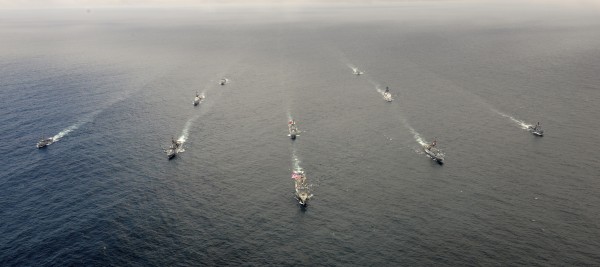U.S. Navy to Deploy Unmanned, Self-Guided Automatic Patrol Boats
| Lord Marin | | Oct 05, 2014 07:56 AM EDT |
(Photo : Reuters Pictures)
Within a year from now, the U.S. Navy's fleet will have new self-guided automatic patrol boats that swarm, attack, or even destroy potentially lethal threats on the water.
The Office of Naval Research based in Arlington has demonstrated the unmanned swarming boat technology over a span of two weeks in August on the James River in Virginia near Fort Eustis, one of the U.S. Navy's biggest areas of fleet concentration. The U.S. Navy simulation involved a transit through a strait, which is similar to the routine passage of U.S. Navy warships passing through the Strait of Hormuz situated in the Persian Gulf.
Like Us on Facebook
The demonstrations included 13 small automatic patrol boats that were escorting and guarding a high-value U.S. Navy ship. Eight of the 13 unmanned patrol boats left the formation and swarmed around an enemy vessel simulating a threat. The U.S. Navy called the demonstration successful.
According to Robert Brizzolara, Office Naval Research program manager, the automatic boats can decide for themselves on what maneuvers to do once a threat is detected. The boats can work together to block and encircle around the path of the potential threatening vessel.
The new self-guided unmanned patrol boats are inflatable and has a rigid-hull, it can also discharge .50 caliber machine guns if needed. But, the said patrol boats can only fire and use lethal force when a human commands the machines to do so. The human in charge of the automatic boats can take over the control of any of the patrol boats at any given moment.
The development of the automatic patrol boats was largely inspired by the USS Cole incident, where 17 sailors were killed and 39 injured by a small boat that was packing explosives.
"I can tell you the systems we just put out on the water would've prevented the Cole," said Rear Adm. Matthew Klunder, Naval Research chief.
©2015 Chinatopix All rights reserved. Do not reproduce without permission
EDITOR'S PICKS
-

Did the Trump administration just announce plans for a trade war with ‘hostile’ China and Russia?
-

US Senate passes Taiwan travel bill slammed by China
-

As Yan Sihong’s family grieves, here are other Chinese students who went missing abroad. Some have never been found
-

Beijing blasts Western critics who ‘smear China’ with the term sharp power
-

China Envoy Seeks to Defuse Tensions With U.S. as a Trade War Brews
-

Singapore's Deputy PM Provides Bitcoin Vote of Confidence Amid China's Blanket Bans
-

China warns investors over risks in overseas virtual currency trading
-

Chinese government most trustworthy: survey
-

Kashima Antlers On Course For Back-To-Back Titles
MOST POPULAR
LATEST NEWS
Zhou Yongkang: China's Former Security Chief Sentenced to Life in Prison

China's former Chief of the Ministry of Public Security, Zhou Yongkang, has been given a life sentence after he was found guilty of abusing his office, bribery and deliberately ... Full Article
TRENDING STORY

China Pork Prices Expected to Stabilize As The Supplies Recover

Elephone P9000 Smartphone is now on Sale on Amazon India

There's a Big Chance Cliffhangers Won't Still Be Resolved When Grey's Anatomy Season 13 Returns

Supreme Court Ruled on Samsung vs Apple Dispute for Patent Infringement

Microsoft Surface Pro 5 Rumors and Release Date: What is the Latest?













